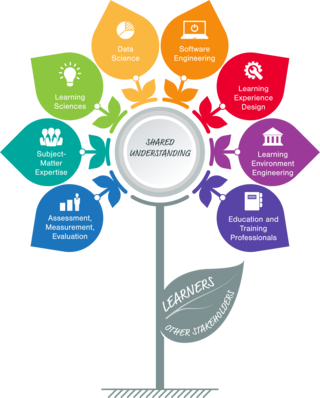Statistical bias, in the mathematical field of statistics, is a systematic tendency in which the methods used to gather data and generate statistics present an inaccurate, skewed or biased depiction of reality. Statistical bias exists in numerous stages of the data collection and analysis process, including: the source of the data, the methods used to collect the data, the estimator chosen, and the methods used to analyze the data. Data analysts can take various measures at each stage of the process to reduce the impact of statistical bias in their work. Understanding the source of statistical bias can help to assess whether the observed results are close to actuality. Issues of statistical bias has been argued to be closely linked to issues of statistical validity.

Analytics is the systematic computational analysis of data or statistics. It is used for the discovery, interpretation, and communication of meaningful patterns in data. It also entails applying data patterns toward effective decision-making. It can be valuable in areas rich with recorded information; analytics relies on the simultaneous application of statistics, computer programming, and operations research to quantify performance.
Educational technology is the combined use of computer hardware, software, and educational theory and practice to facilitate learning. When referred to with its abbreviation, "EdTech," it often refers to the industry of companies that create educational technology. In EdTech Inc.: Selling, Automating and Globalizing Higher Education in the Digital Age, Tanner Mirrlees and Shahid Alvi (2019) argue "EdTech is no exception to industry ownership and market rules" and "define the EdTech industries as all the privately owned companies currently involved in the financing, production and distribution of commercial hardware, software, cultural goods, services and platforms for the educational market with the goal of turning a profit. Many of these companies are US-based and rapidly expanding into educational markets across North America, and increasingly growing all over the world."

The Education Resources Information Center (ERIC) is an online digital library of education research and information. ERIC is sponsored by the Institute of Education Sciences of the United States Department of Education.

Data analysis is the process of inspecting, cleansing, transforming, and modeling data with the goal of discovering useful information, informing conclusions, and supporting decision-making. Data analysis has multiple facets and approaches, encompassing diverse techniques under a variety of names, and is used in different business, science, and social science domains. In today's business world, data analysis plays a role in making decisions more scientific and helping businesses operate more effectively.
The Joint Committee on Standards for Educational Evaluation is an American/Canadian based Standards Developer Organization (SDO). The Joint Committee, created in 1975, represents a coalition of major professional associations formed in 1975 to develop evaluation standards and improve the quality of standardized evaluation. The Committee has thus far published three sets of standards for evaluations. The Personnel Evaluation Standards was published in 1988 and updated in 2008, The Program Evaluation Standards was published in 1994, and The Student Evaluation Standards was published in 2003.
The American Institute of Biological Sciences (AIBS) is a nonprofit scientific public charitable organization. The organization's mission is to promote the use of science to inform decision-making and advance biology for the benefit of science and society.
Audience response is a type of interaction associated with the use of audience response systems, to create interactivity between a presenter and its audience.
Data system is a term used to refer to an organized collection of symbols and processes that may be used to operate on such symbols. Any organised collection of symbols and symbol-manipulating operations can be considered a data system. Hence, human-speech analysed at the level of phonemes can be considered a data system as can the Incan artefact of the khipu and an image stored as pixels. A data system is defined in terms of some data model and bears a resemblance to the idea of a physical symbol system.
Peer assessment, or self-assessment, is a process whereby students or their peers grade assignments or tests based on a teacher's benchmarks. The practice is employed to save teachers time and improve students' understanding of course materials as well as improve their metacognitive skills. Rubrics are often used in conjunction with self- and peer-assessment.

Evidence-based education (EBE) is the principle that education practices should be based on the best available scientific evidence, with randomised trials as the gold standard of evidence, rather than tradition, personal judgement, or other influences. Evidence-based education is related to evidence-based teaching, evidence-based learning, and school effectiveness research.
Pharmacy automation involves the mechanical processes of handling and distributing medications. Any pharmacy task may be involved, including counting small objects ; measuring and mixing powders and liquids for compounding; tracking and updating customer information in databases ; and inventory management. This article focuses on the changes that have taken place in the local, or community pharmacy since the 1960s.
Learning analytics is the measurement, collection, analysis and reporting of data about learners and their contexts, for purposes of understanding and optimizing learning and the environments in which it occurs. The growth of online learning since the 1990s, particularly in higher education, has contributed to the advancement of Learning Analytics as student data can be captured and made available for analysis. When learners use an LMS, social media, or similar online tools, their clicks, navigation patterns, time on task, social networks, information flow, and concept development through discussions can be tracked. The rapid development of massive open online courses (MOOCs) offers additional data for researchers to evaluate teaching and learning in online environments.
Educational data mining (EDM) is a research field concerned with the application of data mining, machine learning and statistics to information generated from educational settings. At a high level, the field seeks to develop and improve methods for exploring this data, which often has multiple levels of meaningful hierarchy, in order to discover new insights about how people learn in the context of such settings. In doing so, EDM has contributed to theories of learning investigated by researchers in educational psychology and the learning sciences. The field is closely tied to that of learning analytics, and the two have been compared and contrasted.
Rexer Analytics’s Annual Data Miner Survey is the largest survey of data mining, data science, and analytics professionals in the industry. It consists of approximately 50 multiple choice and open-ended questions that cover seven general areas of data mining science and practice: (1) Field and goals, (2) Algorithms, (3) Models, (4) Tools, (5) Technology, (6) Challenges, and (7) Future. It is conducted as a service to the data mining community, and the results are usually announced at the PAW conferences and shared via freely available summary reports. In the 2013 survey, 1259 data miners from 75 countries participated. After 2011, Rexer Analytics moved to a biannual schedule.
Barcode technology in healthcare is the use of optical machine-readable representation of data in a hospital or healthcare setting.
Data-informed decision-making (DIDM) gives reference to the collection and analysis of data to guide decisions that improve success. Another form of this process is referred to as data-driven decision-making, "which is defined similarly as making decisions based on hard data as opposed to intuition, observation, or guesswork." DIDM is used in education communities and is also used in other fields in which data is used to inform decisions. While "data based decision-making" is a more common term, "data-informed decision-making" is the preferred term, since decisions should not be based solely on quantitative data. Data-driven decision-making is commonly used in the context of business growth and entrepreneurship. Many educators have access to data system for analyzing student data. These data systems present data to educators in an over-the-counter data format to improve the success of educators' data-informed decision-making. In business, fostering and actively supporting data-driven decision-making in their firm and among their colleagues may be one of the central responsibilities of CIOs or CDOs.

Merative L.P., formerly IBM Watson Health, is an American medical technology company that provides products and services that help clients facilitate medical research, clinical research, real world evidence, and healthcare services, through the use of artificial intelligence, data analytics, cloud computing, and other advanced information technology. Merative is owned by Francisco Partners, an American private equity firm headquartered in San Francisco, California. In 2022, IBM divested and spun-off their Watson Health division into Merative. As of 2023, it remains a standalone company headquartered in Ann Arbor with innovation centers in Hyderabad, Bengaluru, and Chennai.

Learning Engineering is the systematic application of evidence-based principles and methods from educational technology and the learning sciences to create engaging and effective learning experiences, support the difficulties and challenges of learners as they learn, and come to better understand learners and learning. It emphasizes the use of a human-centered design approach in conjunction with analyses of rich data sets to iteratively develop and improve those designs to address specific learning needs, opportunities, and problems, often with the help of technology. Working with subject-matter and other experts, the Learning Engineer deftly combines knowledge, tools, and techniques from a variety of technical, pedagogical, empirical, and design-based disciplines to create effective and engaging learning experiences and environments and to evaluate the resulting outcomes. While doing so, the Learning Engineer strives to generate processes and theories that afford generalization of best practices, along with new tools and infrastructures that empower others to create their own learning designs based on those best practices.
Jenny Grant Rankin is an American educational researcher and author. She is known for her work in improving data presentation, parenting, and career development. She received an Honorary Doctor of Humane Letters from University of La Verne in 2019.







